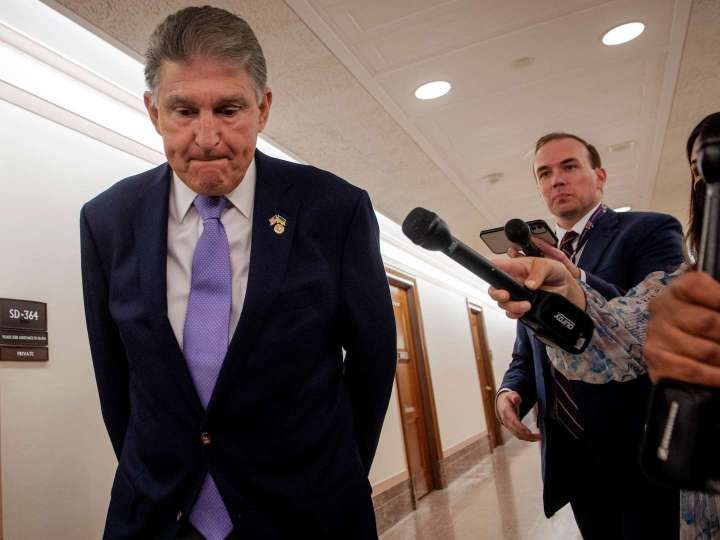Democrats are close to pulling off something that has eluded them for the past year and a half: passing legislation to address climate change and the costs of health care, and doing it without any Republican votes.
What is reconciliation, and what can Democrats get done with it?

Here’s what reconciliation means and what Democrats are able to get done with it.
Reconciliation allows Democrats to avoid a Republican filibuster in the Senate: Most legislation in the Senate these days requires 60 votes to pass, rather than a simple majority of 51. That’s because just one senator out of 100 can filibuster legislation, and the only way to end it is to get 60 senators to agree to move on. Rarely does one party have such a supermajority. The Senate is currently split 50-50. Democrats have only a one-vote majority in the Senate, and only because Vice President Harris can cast a tiebreaking vote.
Despite those narrow margins, Biden has actually had significant success with bipartisan legislation. He’s signed an infrastructure bill into law and a modest gun-control package, the first of its kind in decades. And just this week, the Senate passed legislation investing in the U.S. semiconductor industry.
But there is virtually no chance that even one Republican will support Biden’s climate bill. Senate Republicans are generally skeptical of spending federal money to address climate change and health-care costs. Plus, Republicans are months away from potentially taking back the majority in the Senate, so they would rather not give Biden a big win on one of his major campaign promises. So, Democrats turn to reconciliation.
How reconciliation can help Democrats get around Republican opposition: There is one Senate rule that prevents a filibuster from being used on legislation. Any legislation directly and substantially related to the federal budget can’t be filibustered. The original intent of this rule — which has been in effect in its present form since the 1980s — was to help Congress quickly realign federal law to match spending bills as necessary. The power of the purse is Congress’s No. 1 job, and senators didn’t want to let certain spending changes get bogged down in the endless debate that the filibuster allows for.
But pretty much since its inception, reconciliation has been exploited by party leaders to pass policies that they otherwise couldn’t get a majority vote on. Under President Donald Trump, Republicans used reconciliation to pass major changes to the federal tax code that Democrats decried.
“What has changed over time is the degree to which reconciliation has become basically the only way for a majority party … to pass big, party-defining legislation,” said Molly Reynolds, a congressional budget expert at the Brookings Institution.
What happened the last time Democrats tried to use this: In the first few months of Biden’s presidency, Democrats used reconciliation to pass more coronavirus aid, over Republicans’ objections.
Then, Democrats turned to reconciliation with plans to spend $2 trillion to dramatically reshape the federal government, on everything from child care to education.
But reconciliation comes with some big catches, and three big ones have hung up Democrats for the past year and a half:
- The Senate generally can’t use this tool more than once or twice per year. So they have to reserve their most important legislation for it.
- Everything in the legislation has to relate directly to the budget. That’s a largely subjective measure, decided by the nonpartisan Senate parliamentarian. Last year, when they had hopes of passing a massive spending bill addressing all parts of the economy, Senate Democrats argued to the parliamentarian that extending legal status to millions of immigrants was a federal budget issue. (She said it wasn’t.)
- Any legislation passed under reconciliation still requires a majority vote to pass. With such a narrow majority, that means Democrats can’t lose a single vote among their caucus. And Sen. Joe Manchin III (D-W.Va.), plus at times Sen. Kyrsten Sinema (D-Ariz.), have dashed their party’s hopes many times.
What’s happening now: This current deal came together rather abruptly. Manchin and Senate Majority Leader Charles E. Schumer (D-N.Y.) announced that they reached a deal Wednesday, surprising many of their colleagues, The Washington Post reports. And Manchin agreed to only a fraction of the original $2 trillion spending bill known as Build Back Better; this is one $433 billion and mostly deals with clean energy and climate, and with prescription drug prices. Manchin was persuaded by Democratic leaders’ promises to make some domestic oil and natural gas production easier, as well as economists’ arguments that this wouldn’t contribute to inflation, The Post reports.
But Manchin could change his mind again. Or a more liberal senator could withhold their support, hoping to get more money for their priorities. Democrats know that this bill is probably the only one they’ll be able to pass over Republicans’ objections, potentially for the rest of Biden’s presidency, if Republicans take back one or both chambers of Congress this fall.






